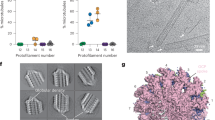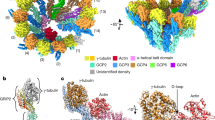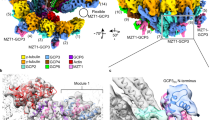Abstract
Two opposing models have been proposed to explain how the γ-tubulin ring complex (γTuRC) induces microtubule nucleation. In the ‘protofilament’ model, the γTuRC induces nucleation as a partially or completely straightened protofilament that is incorporated longitudinally into the wall of the nascent microtubule, whereas the ‘template’ model proposes that the γTuRC acts as a helical template that constitutes the base of the newly-formed polymer. Here we appraise these two models, using high-resolution structural and immunolocalization methods. We show that components of the γTuRC localize to a narrow zone at the extreme minus end of the microtubule and that these ends terminate in a pointed cap. Together, these results strongly favour the template model of microtubule nucleation.
This is a preview of subscription content, access via your institution
Access options
Subscribe to this journal
Receive 12 print issues and online access
$209.00 per year
only $17.42 per issue
Buy this article
- Purchase on Springer Link
- Instant access to full article PDF
Prices may be subject to local taxes which are calculated during checkout




Similar content being viewed by others
References
Keating, T. J., Peloquin, J. G., Rodionov, V. I., Momcilovic, D. & Borisy, G. G. Microtubule release from the centrosome . Proc. Natl Acad. Sci. USA 94, 5078– 5083 (1997).
Mogensen, M. M., Mackie, J. B., Doxsey, S. J., Stearns, T. & Tucker, J. B. Centrosomal deployment of γ-tubulin and pericentrin: evidence for a microtubule-nucleating domain and a minus-end docking domain in certain mouse epithelial cells. Cell Motil. Cytoskeleton 36, 276–290 ( 1997).
Ahmad, F. J., Echeverri, C. J., Vallee, R. B. & Baas, P. W. Cytoplasmic dynein and dynactin are required for the transport of microtubules into the axon. J. Cell Biol. 140, 391– 401 (1998).
Keating, T. J. & Borisy, G. G. Centrosomal and non-centrosomal microtubules. Biol. Cell 91, 321– 329 (1999).
Oakley, B. R., Oakley, C. E., Yoon, Y. & Jung, M. K. γ-tubulin is a component of the spindle pole body that is essential for microtubule function in Aspergillus nidulans. Cell 61, 1289– 1301 (1990).
Horio, T. et al. The fission yeast γ-tubulin is essential for mitosis and is localized at microtubule organizing centers. J. Cell Sci. 99, 693–700 (1991).
Joshi, H. C., Palacios, M. J., McNamara, L. & Cleveland, D. W. γ-tubulin is a centrosomal protein required for cell-cycle-dependent microtubule nucleation. Nature 356, 80– 83 (1992).
Stearns, T. & Kirschner, M. In vitro reconstitution of centrosome assembly and function: the central role of γ-tubulin. Cell 76, 623–637 ( 1994).
Sobel, S. G. & Snyder, M. A highly divergent γ-tubulin gene is essential for cell growth and proper microtubule organization in Saccharomyces cerevisiae. J. Cell Biol. 131, 1775– 1788 (1995).
Li, Q. & Joshi, H. C. γ-tubulin is a minus-end-specific microtubule binding protein. J. Cell Biol. 131, 207–214 (1995).
Zheng, Y., Wong, M. L., Alberts, B. & Mitchison, T. Nucleation of microtubule assembly by a γ-tubulin-containing ring complex. Nature 378, 578–583 ( 1995).
Oegema, K. et al. Characterization of two related Drosophila γ-tubulin complexes that differ in their ability to nucleate microtubules. J. Cell Biol. 144, 721–733 (1999).
Moritz, M., Braunfeld, M. B., Sedat, J. W., Alberts, B. & Agard, D. A. Microtubule nucleation by γ-tubulin-containing rings in the centrosome. Nature 378, 638 –640 (1995).
Pereira, G. & Schiebel, E. Centrosome-microtubule nucleation . J. Cell Sci. 110, 295– 300 (1997).
Wiese, C. & Zheng, Y. γ-tubulin complexes and their interaction with microtubule-organizing centers. Curr. Opin. Struct. Biol. 9, 250–259 ( 1999).
Jeng, R. & Stearns, T. γ-tubulin complexes: size does matter. Trends Cell Biol. 9, 339– 342 (1999).
Schiebel, E. γ-tubulin complexes: binding to the centrosome, regulation and microtubule nucleation. Curr. Opin. Cell Biol. 12, 113 –118 (2000).
Fan, J., Griffiths, A. D., Lockhart, A., Cross, R. A. & Amos, L. A. Microtubule minus ends can be labelled with a phage display antibody specific to α-tubulin. J. Mol. Biol. 259, 325–330 ( 1996).
Erickson, H. P. & Stoffler, D. Protofilaments and rings, two conformations of the tubulin family conserved from bacterial FtsZ to α/β and γ tubulin. J. Cell Biol. 135, 5–8 (1996).
Warner, F. D. & Satir, P. The substructure of ciliary microtubules . J. Cell Sci. 12, 313– 326 (1973).
Martin, O. C., Gunawardane, R. N., Iwamatsu, A. & Zheng, Y. Xgrip109: a γ-tubulin-associated protein with an essential role in γ-tubulin ring complex (γTuRC) assembly and centrosome function. J. Cell Biol. 141, 675–687 ( 1998).
Verde, F., Berrez, J. M., Antony, C. & Karsenti, E. Taxol-induced microtubule asters in mitotic extracts of Xenopus eggs: requirement for phosphorylated factors and cytoplasmic dynein. J. Cell Biol. 112, 1177–1187 (1991).
Echeverri, C. J., Paschal, B. M., Vaughan, K. T. & Vallee, R. B. Molecular characterization of the 50-kD subunit of dynactin reveals function for the complex in chromosome alignment and spindle organization during mitosis . J. Cell Biol. 132, 617– 633 (1996).
Svitkina, T. M. & Borisy, G. G. Correlative light and electron microscopy of the cytoskeleton of cultured cells. Methods Enzymol. 298, 570–592 (1998).
Byers, B., Shriver, K. & Goetsch, L. The role of spindle pole bodies and modified microtubule ends in the initiation of microtubule assembly in Saccharomyces cerevisiae . J. Cell Sci. 30, 331–352 (1978).
Bullitt, E., Rout, M. P., Kilmartin, J. V. & Akey, C. W. The yeast spindle pole body is assembled around a central crystal of Spc42p . Cell 89, 1077–1086 (1997).
O’Toole, E. T. Winey, M. & McIntosh, J. R. High-voltage electron tomography of spindle pole bodies and early mitotic spindles in the yeast Saccharomyces cerevisiae. Mol. Biol. Cell 10, 2017 –2031 (1999).
Erickson, H. P., Taylor, D. W., Taylor, K. A. & Bramhill, D. Bacterial cell division protein FtsZ assembles into protofilament sheets and minirings, structural homologs of tubulin polymers. Proc. Natl Acad. Sci. USA 93, 519–523 (1996).
Knop, M. & Schiebel, E. Spc98p and Spc97p of the yeast g-tubulin complex mediate binding to the spindle pole body via their interaction with Spc110p. EMBO J. 16, 6985– 6995 (1997).
Murphy, S. M., Urbani, L. & Stearns, T. The mammalian γ-tubulin complex contains homologues of the yeast spindle pole body components spc97p and spc98p. J. Cell Biol. 141, 663–674 (1998).
Moritz, M., Zheng, Y., Alberts, B. M. & Oegema, K. Recruitment of the γ-tubulin ring complex to Drosophila salt-stripped centrosome scaffolds. J. Cell Biol. 142, 775– 786 (1998).
Oakley, C. E. & Oakley, B. R. Identification of γ-tubulin, a new member of the tubulin superfamily encoded by mipA gene of Aspergillus nidulans. Nature 338, 662– 664 (1989).
Llanos, R., et al. Tubulin binding sites on γ-tubulin: identification and molecular characterization. Biochemistry 38, 15712–15720 (1999).
Mitchison, T. J. Polewards microtubule flux in the mitotic spindle: evidence from photoactivation of fluorescence. J. Cell Biol. 109, 637– 652 (1989).
Murray, A. W. Cell cycle extracts. Methods Cell Biol. 36, 581–605 (1991).
Wittmann, T. & Hyman, T. Recombinant p50/dynamitin as a tool to examine the role of dynactin in intracellular processes. Methods Cell Biol. 61, 137–143 ( 1999).
Nogales, E., Wolf, S. G. & Downing, K. H. Structure of the α/β-tubulin dimer by electron crystallography. Nature 391, 199– 203 (1998).
Hughes, D. A. & Beesley, J. E. Preparation of colloidal gold probes. Methods Mol. Biol. 80, 275– 282 (1998).
Acknowledgements
We thank C. Echeverri and R. Vallee for the p50/dynamitin construct, R. Vale and F. McNally for the hKin560-his construct, B. Bement for gravid frogs and T. Svitkina for assistance with electron-microscopy work. We are grateful to B. Bement, J. Peloquin and members of the Borisy laboratory for discussions and advice, to S. Limbach for technical assistance and to L. Olds for help in preparing the figures. This work was supported by a Postdoctoral Fellowship from the American Cancer Society (to T.J.K.) and by NIH grant GM25062 (to G.G.B.).
Correspondence and requests for materials should be addressed to T.J.K.
Author information
Authors and Affiliations
Corresponding author
Rights and permissions
About this article
Cite this article
Keating, T., Borisy, G. Immunostructural evidence for the template mechanism of microtubule nucleation . Nat Cell Biol 2, 352–357 (2000). https://doi.org/10.1038/35014045
Received:
Revised:
Accepted:
Published:
Issue Date:
DOI: https://doi.org/10.1038/35014045
This article is cited by
-
The catalytic subunit of DNA polymerase δ inhibits γTuRC activity and regulates Golgi-derived microtubules
Nature Communications (2017)
-
Ring closure activates yeast γTuRC for species-specific microtubule nucleation
Nature Structural & Molecular Biology (2015)
-
Microtubule nucleation at the centrosome and beyond
Nature Cell Biology (2015)
-
Subdiffraction-resolution fluorescence microscopy reveals a domain of the centrosome critical for pericentriolar material organization
Nature Cell Biology (2012)
-
Microtubule nucleation by γ-tubulin complexes
Nature Reviews Molecular Cell Biology (2011)



